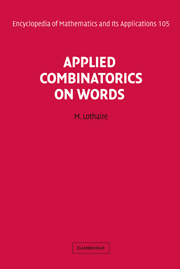Book contents
- Frontmatter
- Contents
- Preface
- Chapter 1 Algorithms on Words
- Chapter 2 Structures for Indexes
- Chapter 3 Symbolic Natural Language Processing
- Chapter 4 Statistical Natural Language Processing
- Chapter 5 Inference of Network Expressions
- Chapter 6 Statistics on Words with Applications to Biological Sequences
- Chapter 7 Analytic Approach to Pattern Matching
- Chapter 8 Periodic Structures in Words
- Chapter 9 Counting, Coding, and Sampling with Words
- Chapter 10 Words in Number Theory
- References
- General Index
Chapter 5 - Inference of Network Expressions
Published online by Cambridge University Press: 05 June 2013
- Frontmatter
- Contents
- Preface
- Chapter 1 Algorithms on Words
- Chapter 2 Structures for Indexes
- Chapter 3 Symbolic Natural Language Processing
- Chapter 4 Statistical Natural Language Processing
- Chapter 5 Inference of Network Expressions
- Chapter 6 Statistics on Words with Applications to Biological Sequences
- Chapter 7 Analytic Approach to Pattern Matching
- Chapter 8 Periodic Structures in Words
- Chapter 9 Counting, Coding, and Sampling with Words
- Chapter 10 Words in Number Theory
- References
- General Index
Summary
Introduction
This chapter introduces various mathematical models and combinatorial algorithms that are used to infer network expressions which appear repeated in a word or are common to a set of words, where by network expression is meant a regular expression without Kleene closure on the alphabet of the input word(s). A network expression on such an alphabet is therefore any expression built up of concatenation and union operators. For example, the expression A(C + G)T concatenates A with the union (C + G) and with T. Inferring network expressions means discovering such expressions which are initially unknown. The only input is the word(s) where the repeated (or common) expressions will be sought. This is in contrast with another problem, we shall not be concerned with, which searches for a known expression in a word(s) both of which are in this case part of the input. The inference of network expressions has many applications, notably in molecular biology, system security, text mining, etc. Because of the richness of the mathematical and algorithmic problems posed by molecular biology, we concentrate on applications in this area. The network expressions considered may therefore contain spacers where by spacer is meant any number of don't care symbols (a don't care is a symbol that matches anything). Constrained spacers are consecutive don't care symbols whose number ranges over a fixed interval of values. Network expressions with don't care symbols but no spacers are called “simple” while network expressions with spacers are called “flexible” if the spacers are unconstrained, and “structured” otherwise.
Information
- Type
- Chapter
- Information
- Applied Combinatorics on Words , pp. 241 - 267Publisher: Cambridge University PressPrint publication year: 2005
